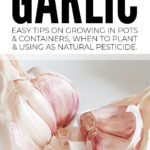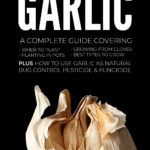
Growing garlic is a great idea for new gardeners as it is easy to grow and very beneficial in our home and garden.
Garlic tastes great in everyday recipes but is also a natural antibiotic and anti-fungal for simple home remedies.
And in the garden garlic can :
- Help other plants flourish
- Repel pests
- Protect & feed soil
- Control fungal infections.
So in this guide to growing garlic I will first take you through the basics :
- When To Plant Garlic
- The Best Garlic To Grow
- How To Grow Garlic From Cloves
- Growing Garlic In Containers
- Growing Garlic In Raised Beds
And then explain how to plant garlic as protective companion plants and use it in a DIY pesticide & fungicide spray.
Do save the guide for quick reference.
Table of Contents
When To Plant Garlic

The optimum time to plant garlic for your kitchen is in late autumn.
But you can still plant it in late winter and early spring and some varieties e.g. Picardy Wight can be planted right through until the end of April.
You can plant garlic as a companion plant any time as long as heat is under 80f/27c and you keep it moist.
Which Garlic Is Best To Grow

There are two main types of garlic that you can choose from :
- Hard Neck Garlic
- Soft Neck Garlic
Each has different benefits and do better in different climates at different times of the year. So the best choice for your garden will depend on where you are and when you are planting.
Hard Neck Garlic
Hard neck garlic is a flowering garlic that typically has bigger heads with fewer tastier cloves. It does better in cold climates but doesn't store as well.
Good hard neck varieties include :
- Purple Stripe
- Rocambole
- Music
- Porcelain

Soft Neck Garlic
Soft neck garlic has smaller heads of garlic with more cloves that will grow better in early spring and will store well. Soft neck garlic doesn't typically flower.
Good soft neck varieties include :
- Cristo
- Early Purple Wight
- Iberian Wight
- California Early
- Solent Wight
How To Grow Garlic From Cloves

It is is very easy to grow garlic from cloves. All you need to remember is :
- Plant clove with points upwards.
- Point should be an inch below soil.
- For the kitchen, plant 15 cm / 6 inches apart from each other.
If you are planting garlic as a companion plant for non-root veg e.g. spinach, you can plant cloves closer.
Once your garlic cloves are planted :
- Water well until bulbs are formed.
- Then water lightly to prevent rot.
- Cut flowers if growing for kitchen as these reduce bulb growth.
You can start to harvest garlic when the leaves begin to yellow and brown.
Starting Garlic In Water
You can start garlic in water inside, as you can mint, oregano and more.
It's a good way to sprout and spread cloves if you are using garlic as pest control for e.g. tomatoes, spinach, collards and carrots.

To start garlic in water :
- Fill jar right up with water.
- Place garlic head on top of jar, so bottom of garlic is touching water.
- Keep jar in your kitchen but not direct sunlight.
Roots and green shoots will appear in days. In 1-2 weeks you should have 2 inches of root and your garlic heads are ready to split.
Separate out the cloves gently disentangling the roots from each clove and then plant out as before but with a deep enough hole for the roots.
Growing Garlic In Containers
Garlic is easy to grow in pots and containers which you can move around to protect different vegetables from pests at different times of the year.

If you are short on space choose smaller soft neck garlic varieties that will have healthier growth in pots.
To plant garlic in pots & containers :
- Pick containers that are at least 15cm / 6 inches deep.
- Ensure containers drain well.
- Plant cloves 4 inches apart.
- Plant cloves away from edge of pot so space for bulb to grow.
- As before plant cloves point up, with point 1 inch below soil line.
Be careful not to over water garlic in pots as this can cause the bulbs to rot.
Growing Garlic In Raised Beds
Garlic has big anti-fungal benefits for soil and plants in our vegetable garden.

So it is a great idea to interplant garlic with other vegetables and also to plant some garlic as a pest repellent border around the edge of raised beds.
You can plant your cloves in the same way as we have above :
- In a roughly 2 inch hole.
- Point upwards.
- With point 1 inch below soil.
Garlic Companion Planting

Garlic companion planting can help vegetables, fruit, flowers and herbs thrive. To enjoy these benefits we can :
- Interplant it with other plants.
- Sow as a pest protective border.
- Grow in easy to move pots for rapid pest control as needed.
But garlic isn't a great companion plant for absolutely everything in the garden so we need to be clear about :
- Plants That Love Garlic
- Plants That Do Not Like Garlic
Plants That Love Garlic
Garlic is a valuable companion plant for all these different plants :
- Nightshades
- Brassicas
- Potatoes
- Root Vegetables

- Spinach
- Fruit Trees
- Berries
- Roses
- Herbs
Nightshades
Garlic helps protect tomatoes, peppers & aubergine from blight, verticillium wilt & mould. It also repels spider mites.

Brassicas
Garlic repels moths and their very hungry caterpillars including cabbage loopers and cabbage worms from :
- Broccoli
- Brussels sprouts
- Cabbages
- Cauliflower
- Collards
- Kale
- Kohlrabi.
Garlic can also help to repel cabbage root fly maggots and whitefly.
Potatoes
Garlic can help to protect potato crops from horrible late blight.
Root Vegetables

The strong smell of garlic can repel carrot fly from carrots. The sulphur garlic emits into the soil can protect beetroots from fungal disease and rot.
Spinach
Garlic repels aphids from spinach. Planted together garlic and spinach can heal soil as they have complementary antimicrobial properties.
Fruit Trees

Planted beneath fruit trees, garlic can repel aphids and fruit moths. Fruit trees can also use the sulphur from garlic to fight fungal diseases such as apple scab and peach leaf curl
Fruit
Interplanted garlic can help to repel spider mites from strawberries although some gardeners claim it reduces the size of strawberries.
Roses

Garlic grown around roses can help repel aphids and protect roses from ugly blackspot fungi.
Herbs
Garlic is typically a companion plant to help other plants but traditionally chamomile has been used to encourage bigger & more flavoursome garlic bulbs for the kitchen.
Plants That Do Not Like Garlic
Garlic - and other alliums such as chives - should not be grown near these vegetables and plants as they can stunt their growth :
- Peas
- Beans
- Asparagus
- Sage
Some gardeners claim garlic stunts parsley growth but others deny this and maintain it is a good companion plant for repelling carrot fly from parsley.
Planting Garlic To Repel Bugs

Planting garlic in your vegetable garden can repel all sorts of bugs including :
- Gnats
- Spider mites
- Moths
- Beetles
- Aphids
- Ants
- Snails.
Garlic's pungent smell can deliver a double whammy of protection as it :
- Repels bugs who hate the smell
- Camouflages the smell of the plants that they do like such as carrots and brassicas.
As mentioned previously, you can interplant garlic and plant it as a protective border and sow cloves closer together than you would if purely focused on your garlic harvest.
If you are gardening in a tiny space with little room for garlic you could instead plant chives, another allium with similar benefits as a companion plant.
Planting Garlic To Deter Pests

You can also grow garlic to protect your vegetable garden and flower beds from bigger pests including :
- Foxes
- Rabbits
- Mice
- Rats
- Moles
- Deer
Plant your garlic as an aromatic barrier fence at key entrance points to your garden where pests typically come in.
Typically hard necked garlic is stronger smelling than soft necked varieties so can better deter your hungry pests. Elephant garlic grows taller so can be a more effective barrier for larger pests.
You can also spray quick DIY garlic pesticide around key entrance points.
Garlic Pesticide & Fungicide Spray

You can easily make a simple DIY pesticide & fungicide spray from the garlic growing in your garden.
You can spray it weekly preventatively to repel unwanted bugs and fungal disease such as mildew and black spot.
You can also use it to kill infestations of bugs e.g. aphids or fungal infections.
To make the DIY garlic spray :
- Split garlic bulb into cloves.
- Blend with 1 cup of water.
- Blend again with 2 tablespoons of dish soap & 3 cups of water.
- Seep for at least 12 hours.
- Strain through fine seive.
- Pour into spray bottle.
- Test spray on single leaf & check impact after 24 hours.
- Spray weekly from 6-12 inches distance on vulnerable leaves.
- Spray plants in shade or the evening, not in full sun.
- Keep spray in fridge.
And there you go, all the must know tips about growing garlic as a companion plant to help your garden thrive.
Do save for quick reference and for more simple, practical gardening tips do follow me on Pinterest.

Original images shared under Creative Commons : garlic in herb garden, bed of garlic, garlic in pots. Other images by sloely or rawpixel.















Bukky says
Hi! I enjoyed reading your post. Quickly, how well does garlic benefit corn when planted together?
Alice says
Hmm, not totally sure as not a corn grower. I have never seen anything saying don't but I would have thought that corn would prefer much hotter, sunnier weather than garlic. We've had a very cool summer in London so far but the garlic on the sunniest side of my garden still gave up in May. If you're trying to repel aphids and beetles from corn I've seen basil, dill (attracts good bug eating wasps) and nasturtiums recommended as companion plants. Hope that helps. Best wishes Alice